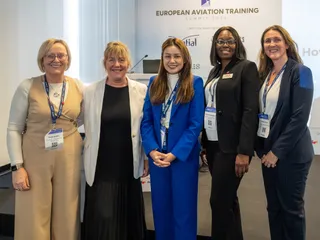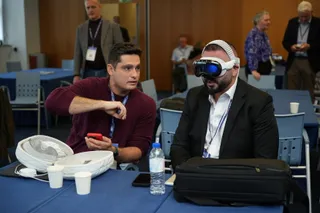XR Flight Simulation: Rethinking Aviation Training Technology
Contact Our Team
For more information about how Halldale can add value to your marketing and promotional campaigns or to discuss event exhibitor and sponsorship opportunities, contact our team to find out more
The Americas -
holly.foster@halldale.com
Rest of World -
jeremy@halldale.com

Key Takeaways
- 50% faster to solo: US Air Force students reached solo competency in 10 sorties instead of 20 after introducing XR training
- 33 out of 40 maneuvers improved: First-flight performance increased dramatically with XR pre-training, with the remaining seven maneuvers matching previous standards
- $50 million annual savings: Air Force reduced training by months, generating substantial cost savings while improving outcomes
- Eye tracking reveals cognitive load: Modern XR headsets track eye movement and measure cognitive load for unprecedented training insights
- Accessibility drives adoption: Small footprint, lower cost, and decentralized deployment make XR more accessible than traditional simulators
From Fighter Pilot to XR Advocate
Timothy "TJ" Moser brought a unique perspective to EATS 2025—28 years of flying fighters and trainers for the US Air Force, followed by leading pilot training transformation that infused extended reality into the curriculum. Now Account Executive for Varjo Technologies, Moser shared compelling data on XR's effectiveness. "I don't think the dome is going away," Moser acknowledged. "But there are ways you can rethink how that training is done. The visuals you can deliver through XR are really stunning, and for many training tasks, that's the better way."
Why Innovate? Addressing the Global Pilot Shortage
"We had a pilot shortage. That pilot shortage is global," Moser explained. "You can't just hire pilots. You've got to train them. Training takes time and costs money. If you can find anything that helps accelerate through that training, you can create pilots faster." But adoption depends on certification. "The real key is FAA and EASA certifications. Unless you can get certified simulators, pilots can't log these as required hours."
The XR Advantage: Accessibility and Availability
Moser outlined XR's practical benefits: Small Footprint: XR trainers fit in standard rooms without special electrical or HVAC requirements. Lower Cost: Organizations can deploy more units at lower price points than full-flight simulators. Decentralized training: "You don't have to fly somebody to a flight training center. You might be able to have these somewhere else." He recalled traditional simulator constraints: "We had four flight sims on the base, and maybe only two, and one was always broken. Your hours started at four in the morning, went till two or three in the morning." "Accessibility is probably the best ability of XR—its availability. If you can have more of these because they're lower cost, small footprint, they're more accessible."
Where XR Excels: Ab Initio and Visual-Centric Training
"XR has proven most effective in ab initio, early-stage training, all the way up to recurring training. But especially in cockpits like a helicopter or eVTOL, or anything with a large canopy where you've got a lot of visuals, that's where we've really seen the most impact." Modern XR headsets combine virtual and real-world elements through cameras. "Everything here is virtual reality, and then everything down here is through cameras—you're seeing your hands, all of your cockpit, your instruments, all knob switch styles. You get that full feel that pilots require. You can do things like EFIS and beyond just the basics." The cameras serve dual purposes: tracking headset position in space and providing hand tracking so pilots can manipulate physical controls while immersed in virtual environments.
Revolutionary Eye Tracking Technology
One of XR's most powerful capabilities lies in eye tracking—technology generating unprecedented training data. "The inside cameras can track your eyes, and they can predictively track where your eyes are about to look just milliseconds before you move your eyes. All that data can be collected and utilized later." Moser demonstrated heat mapping, comparing instructor and student scan patterns during the final approach. "You can see the instructor is more focused where they're looking for the aim point, more even between airspeed and altitude. For the students, their aim point is probably all over the place." The technology measures cognitive load through eye behavior and facial features, enabling objective debriefing: "When your student got slow on airspeed, and you ask, 'Were you checking your airspeed?' and they say, 'I was checking my airspeed,' let's go back and look at the tapes. Guess what? You weren't looking around. You didn't watch your airspeed."
Overcoming Technical Challenges
Moser addressed perceived XR limitations: Foveated Rendering: "You can really focus it in foveated rendering, in a small area that allows you to scan your instruments, get your eyes back outside, and fly the aircraft." Hand Tracking: External cameras track hands as they manipulate controls. Night Training: "You can instantly turn it into night in a perfectly bright room. With the software, you just make it night, and you can still see everything you would normally see inside a cockpit." Ergonomics: Weight distribution improvements have addressed early comfort complaints. "Nowadays, I hardly even notice that I have it on." Cyber Sickness: Faster autofocus, predictive eye tracking, and motion platforms synced with visuals have eliminated latency-induced discomfort.
The Evidence: Air Force Results
When the Air Force Chief of Staff said "scale this" in 2019, Moser admitted skepticism: "I was one of the ones in the camp of there are so many challenges. That was six years ago, and those have been overcome."
The results proved transformative: 50% Faster to Solo: "It used to be an average of about 20 sorties to get to solo, and we cut that down to 10. We had some students solo after four sorties because they've done so many reps in the simulator ahead of time." Improved First-Flight Performance: Analysis showed "33 out of 40" maneuvers on the first flight improved, with the other seven matching previous performance. Better Learning: "Students weren't feeling overwhelmed on their first flight. They were actually learning on their first flight." Substantial Cost Savings: The improvements enabled cutting "training by a couple of months, contributing to $50 million annually in savings." Embry-Riddle Aeronautical University replicated similar results, achieving 30% faster time to solo.
The Future: Complementing, Not Replacing
Despite XR's advantages, Moser sees it as training augmentation rather than replacement. "I see this as training augmentation early on, where visuals are essential—ab initio, early stage training." Full-flight simulators retain advantages for specific training: "Upset prevention and recovery training is challenging to do in a simulator anywhere. Stall training is much more suited for the actual aircraft or full-flight sim." XR's role is enabling better training earlier and "taking some pressure off those classic sims." By teaching foundational competencies in accessible XR devices, organizations can "focus the real training that you can only do in those bigger, more costly sims." He envisions deployment ratios of "four to one or eight to one—whatever works for your training solution." "The technology of XR is here to stay. It's still early. The technology will continue to get better. Those challenges have been overcome over the past six years. You imagine what happens in the next two, three, four, five years—this is going to be something we're probably not even talking about anymore." For training organizations facing pilot shortages, rising costs, and the need for faster, more effective Training, XR offers a proven path forward—backed by military results showing dramatic improvements in time to competency, performance quality, and cost efficiency.
Interested in regulatory pathways for emerging training technologies? Join us at WATS 2026 in Orlando, Florida, from May 5-7.
Save your seat for WATS 2026!

